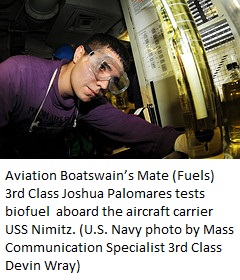 The U.S. Navy is moving full-steam ahead, despite some obstacles that have come up for its program on biofuels. This article from Motley Fool posted on the NASDAQ website says the Navy wants to get 50 percent of its energy from alternatives to petroleum. To make sure these fuels are ready for the fight, the service is looking at drop-in fuels, and with a provision in the recent Defense Department appropriations, the Navy has to do it at the same cost as petroleum-based fuels.
The U.S. Navy is moving full-steam ahead, despite some obstacles that have come up for its program on biofuels. This article from Motley Fool posted on the NASDAQ website says the Navy wants to get 50 percent of its energy from alternatives to petroleum. To make sure these fuels are ready for the fight, the service is looking at drop-in fuels, and with a provision in the recent Defense Department appropriations, the Navy has to do it at the same cost as petroleum-based fuels.
In the past the Navy has tested advanced biofuels that cost upward of $26 per gallon. That price, of course, didn’t sit well with many taxpayers, which is why the National Defense Authorization Act was passed, which limited the Department of Defense from paying higher prices for alternative fuels than it pays for petroleum-based fuels.
In order to combat the high price of commercial drop-in biofuels, the Navy and the U.S. Department of Agriculture, or USDA, worked together to create the Farm-to-Fleet program. Under the program, producers seeking to offer drop-in biofuels can apply to the USDA Commodity Credit Corporation for grants that will offset the cost of the feedstocks needed to produce these drop-in biofuels. Further, some drop-in biofuels can qualify for Renewable Identification Numbers, which can be sold to further offset the cost. The hope is that between these two offsets producers will be able to supply a drop-in jet fuel, which is the most costly fuel the navy uses, for the same price as traditional jet fuel.
Earlier this summer, a government procurement report showed the U.S. Navy has for the first time put biofuels in the mix for requests for military-specification diesel fuel and jet fuel.

